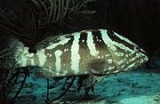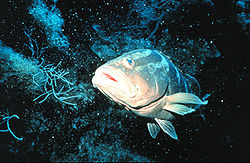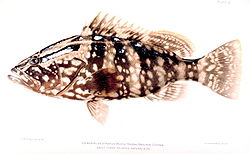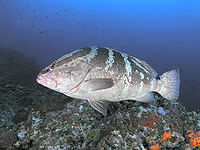
Nassau grouper
Encyclopedia
The Nassau grouper is one of the large number of Perciform fish
in the family Serranidae
that are commonly referred to as grouper
s. It is the most important of the groupers for commercial fishery in the West Indies but has been endangered by overfishing.
The Nassau grouper is a U.S. National Marine Fisheries Service
Species of Concern. Species of Concern are those species about which the U.S. Government’s National Oceanic and Atmospheric Administration
, National Marine Fisheries Service, has some concerns regarding status and threats, but for which insufficient information is available to indicate a need to list the species under the U.S. Endangered Species Act (ESA).
 The Nassau grouper is a medium to large fish, growing to over a meter in length and up to 25 kilograms in weight. It has a thick body and large mouth, which it uses to "inhale" prey. Its colour varies depending on an indivudual fishes circumstances and environment. In shallow water (up to 60 feet), the grouper is a tawny color, but specimens that live in deeper waters are pinkish or red, or sometimes orange-red color. Superimposed on this base colour are a number of lighter stripes, darker spots, bars and patterns including black spots below and behind the eye, and a forked stripe on the top of head
The Nassau grouper is a medium to large fish, growing to over a meter in length and up to 25 kilograms in weight. It has a thick body and large mouth, which it uses to "inhale" prey. Its colour varies depending on an indivudual fishes circumstances and environment. In shallow water (up to 60 feet), the grouper is a tawny color, but specimens that live in deeper waters are pinkish or red, or sometimes orange-red color. Superimposed on this base colour are a number of lighter stripes, darker spots, bars and patterns including black spots below and behind the eye, and a forked stripe on the top of head
s; it is one of the largest fish to be found around Coral Reef
s. It can be found anywhere from the shoreline to nearly water that are up to 100 m deep. The Nassau Grouper lives in the western Atlantic Ocean
, from Bermuda
, Florida
and the Bahamas in the north to southern Brazil
, but it is only found in a few places in the Gulf of Mexico
, most notably along the coast of Belize
. It is a solitary fish, feeding in the daytime, mainly on other fish and small crustaceans like crab
s and small lobsters. It spawns in December and January, always around the time of the full moon, and always in the same locations. By the light of the full moon, huge numbers of the grouper cluster together to mate in mass spawning. One reason the Nassau Grouper fisheries are so depleted is that its huge spawning groups make easy targets for fishermen, who scoop up large numbers of reproducing fish, who then can obviously not reproduce. Many other grouper and snapper species are in trouble of becoming endangered or extinct for the same reason.
. However, its numbers have been sharply reduced by overfishing in recent years, and it is a slow breeder. Furthermore its historic spawning areas are easily targeted for fishing, which tends to remove the reproductively active members of the group. The species is therefore highly vulnerable to overexploitation
, and is recognised as endangered on the IUCN Red List
. The governments of the United States
, the Cayman Islands
and the Bahamas have banned fishing for the Nassau Grouper in recent years. In the Cayman Islands fishing in the spawning holes of the grouper has been banned until the end of 2011, and in the case of the Bahamas fishing for the groupers in the months of December 2003 to February 2004 was also stopped. The Nassau Grouper is in a very high rate decline and is at serious risk of becoming extinct.
A large spawning site for the species is located at Glover's Reef
, off the Belizean coast. It has been identified as one of only two viable sites remaining for the species, of nine originally known locations. In 2002, this area was declared a special marine reserve, permanently closed to fishing.
There have been many conservation methods that have been put in place to help the grouper. There are closed seasons when you are not allowed to fish for the grouper. These seasons take place during the spawning season. There are regulations allowing only fish over 3 lbs to be harvested to give the younger fish a chance to spawn. There are protected areas where you are not allowed to fish and there is a complete ban on fishing the grouper in U.S. federal waters. Also there are protections of the spawning sites at all times in certain places.

 The Nassau grouper has been depicted on postage stamps of Cuba
The Nassau grouper has been depicted on postage stamps of Cuba
(1965, 1975), the Bahamas (1971 5 cent), and Antigua and Barbuda
(1987 40c).
The threats to the Grouper are:
Over fishing-
Fishing during the breeding period.-
Habitat loss-
Pollution-
Invasive species-
Catching undersized grouper. There are conservations to try to help protect the grouper against these threats.
The Nassau Grouper was placed on the World Conservation Union’s redlist of threatened species in 1996 and it was determined to be endangered because its population has declined by 60% in the past 30 years.
It is estimated that over a third of spawning aggregations have disappeared and the grouper is considered to be commercially extinct in some areas.
The current population of the Nassau Grouper is estimated to be more that 10,000 mature individuals but the population is estimated to still be decreasing. Along with the grouper their suitable habitat is declining. They need quality coral reef habitat to survive. So due to the over fishing and loss of habitat the outlook for the Nassau Grouper is not optimistic.
http://www.breef.org/Portals/0/Nassau%20Grouper%20notes.pdf
Fish
Fish are a paraphyletic group of organisms that consist of all gill-bearing aquatic vertebrate animals that lack limbs with digits. Included in this definition are the living hagfish, lampreys, and cartilaginous and bony fish, as well as various extinct related groups...
in the family Serranidae
Serranidae
Serranidae is a large family of fishes, belonging to the order Perciformes. The family contains about 450 species of serranids in 64 genera, including the sea basses and the groupers...
that are commonly referred to as grouper
Grouper
Groupers are fish of any of a number of genera in the subfamily Epinephelinae of the family Serranidae, in the order Perciformes.Not all serranids are called groupers; the family also includes the sea basses. The common name grouper is usually given to fish in one of two large genera: Epinephelus...
s. It is the most important of the groupers for commercial fishery in the West Indies but has been endangered by overfishing.
The Nassau grouper is a U.S. National Marine Fisheries Service
National Marine Fisheries Service
The National Marine Fisheries Service is a United States federal agency. A division of the National Oceanic and Atmospheric Administration and the Department of Commerce, NMFS is responsible for the stewardship and management of the nation's living marine resources and their habitat within the...
Species of Concern. Species of Concern are those species about which the U.S. Government’s National Oceanic and Atmospheric Administration
National Oceanic and Atmospheric Administration
The National Oceanic and Atmospheric Administration , pronounced , like "noah", is a scientific agency within the United States Department of Commerce focused on the conditions of the oceans and the atmosphere...
, National Marine Fisheries Service, has some concerns regarding status and threats, but for which insufficient information is available to indicate a need to list the species under the U.S. Endangered Species Act (ESA).
Species Description

Ecology
The Nassau grouper lives in the sea, preferring to be near reefReef
In nautical terminology, a reef is a rock, sandbar, or other feature lying beneath the surface of the water ....
s; it is one of the largest fish to be found around Coral Reef
Coral reef
Coral reefs are underwater structures made from calcium carbonate secreted by corals. Coral reefs are colonies of tiny living animals found in marine waters that contain few nutrients. Most coral reefs are built from stony corals, which in turn consist of polyps that cluster in groups. The polyps...
s. It can be found anywhere from the shoreline to nearly water that are up to 100 m deep. The Nassau Grouper lives in the western Atlantic Ocean
Atlantic Ocean
The Atlantic Ocean is the second-largest of the world's oceanic divisions. With a total area of about , it covers approximately 20% of the Earth's surface and about 26% of its water surface area...
, from Bermuda
Bermuda
Bermuda is a British overseas territory in the North Atlantic Ocean. Located off the east coast of the United States, its nearest landmass is Cape Hatteras, North Carolina, about to the west-northwest. It is about south of Halifax, Nova Scotia, Canada, and northeast of Miami, Florida...
, Florida
Florida
Florida is a state in the southeastern United States, located on the nation's Atlantic and Gulf coasts. It is bordered to the west by the Gulf of Mexico, to the north by Alabama and Georgia and to the east by the Atlantic Ocean. With a population of 18,801,310 as measured by the 2010 census, it...
and the Bahamas in the north to southern Brazil
Brazil
Brazil , officially the Federative Republic of Brazil , is the largest country in South America. It is the world's fifth largest country, both by geographical area and by population with over 192 million people...
, but it is only found in a few places in the Gulf of Mexico
Gulf of Mexico
The Gulf of Mexico is a partially landlocked ocean basin largely surrounded by the North American continent and the island of Cuba. It is bounded on the northeast, north and northwest by the Gulf Coast of the United States, on the southwest and south by Mexico, and on the southeast by Cuba. In...
, most notably along the coast of Belize
Belize
Belize is a constitutional monarchy and the northernmost country in Central America. Belize has a diverse society, comprising many cultures and languages. Even though Kriol and Spanish are spoken among the population, Belize is the only country in Central America where English is the official...
. It is a solitary fish, feeding in the daytime, mainly on other fish and small crustaceans like crab
Crab
True crabs are decapod crustaceans of the infraorder Brachyura, which typically have a very short projecting "tail" , or where the reduced abdomen is entirely hidden under the thorax...
s and small lobsters. It spawns in December and January, always around the time of the full moon, and always in the same locations. By the light of the full moon, huge numbers of the grouper cluster together to mate in mass spawning. One reason the Nassau Grouper fisheries are so depleted is that its huge spawning groups make easy targets for fishermen, who scoop up large numbers of reproducing fish, who then can obviously not reproduce. Many other grouper and snapper species are in trouble of becoming endangered or extinct for the same reason.
Conservation
The Nassau grouper is fished both commercially and for sport; it is less shy than other groupers, and is readily approached by scuba diversScuba diving
Scuba diving is a form of underwater diving in which a diver uses a scuba set to breathe underwater....
. However, its numbers have been sharply reduced by overfishing in recent years, and it is a slow breeder. Furthermore its historic spawning areas are easily targeted for fishing, which tends to remove the reproductively active members of the group. The species is therefore highly vulnerable to overexploitation
Overexploitation
Overexploitation, also called overharvesting, refers to harvesting a renewable resource to the point of diminishing returns. Sustained overexploitation can lead to the destruction of the resource...
, and is recognised as endangered on the IUCN Red List
IUCN Red List
The IUCN Red List of Threatened Species , founded in 1963, is the world's most comprehensive inventory of the global conservation status of biological species. The International Union for Conservation of Nature is the world's main authority on the conservation status of species...
. The governments of the United States
United States
The United States of America is a federal constitutional republic comprising fifty states and a federal district...
, the Cayman Islands
Cayman Islands
The Cayman Islands is a British Overseas Territory and overseas territory of the European Union located in the western Caribbean Sea. The territory comprises the three islands of Grand Cayman, Cayman Brac, and Little Cayman, located south of Cuba and northwest of Jamaica...
and the Bahamas have banned fishing for the Nassau Grouper in recent years. In the Cayman Islands fishing in the spawning holes of the grouper has been banned until the end of 2011, and in the case of the Bahamas fishing for the groupers in the months of December 2003 to February 2004 was also stopped. The Nassau Grouper is in a very high rate decline and is at serious risk of becoming extinct.
A large spawning site for the species is located at Glover's Reef
Glover's Reef
Glover's Reef is a partially submerged atoll located off the southern coast of Belize, approximately 45 kilometres from the mainland. It forms part of the outermost boundary of the Belize Barrier Reef.-Topography:...
, off the Belizean coast. It has been identified as one of only two viable sites remaining for the species, of nine originally known locations. In 2002, this area was declared a special marine reserve, permanently closed to fishing.
There have been many conservation methods that have been put in place to help the grouper. There are closed seasons when you are not allowed to fish for the grouper. These seasons take place during the spawning season. There are regulations allowing only fish over 3 lbs to be harvested to give the younger fish a chance to spawn. There are protected areas where you are not allowed to fish and there is a complete ban on fishing the grouper in U.S. federal waters. Also there are protections of the spawning sites at all times in certain places.
Status Reviews
Sadovy and Eklund (1999) is the most complete status review of the species.

Cuba
The Republic of Cuba is an island nation in the Caribbean. The nation of Cuba consists of the main island of Cuba, the Isla de la Juventud, and several archipelagos. Havana is the largest city in Cuba and the country's capital. Santiago de Cuba is the second largest city...
(1965, 1975), the Bahamas (1971 5 cent), and Antigua and Barbuda
Antigua and Barbuda
Antigua and Barbuda is a twin-island nation lying between the Caribbean Sea and the Atlantic Ocean. It consists of two major inhabited islands, Antigua and Barbuda, and a number of smaller islands...
(1987 40c).
The threats to the Grouper are:
Over fishing-
Fishing during the breeding period.-
Habitat loss-
Pollution-
Invasive species-
Catching undersized grouper. There are conservations to try to help protect the grouper against these threats.
The Nassau Grouper was placed on the World Conservation Union’s redlist of threatened species in 1996 and it was determined to be endangered because its population has declined by 60% in the past 30 years.
It is estimated that over a third of spawning aggregations have disappeared and the grouper is considered to be commercially extinct in some areas.
The current population of the Nassau Grouper is estimated to be more that 10,000 mature individuals but the population is estimated to still be decreasing. Along with the grouper their suitable habitat is declining. They need quality coral reef habitat to survive. So due to the over fishing and loss of habitat the outlook for the Nassau Grouper is not optimistic.
For Further Information
- http://www.oar.noaa.gov/spotlite/archive/spot_spawn.html
- http://www.flmnh.ufl.edu/fish/Gallery/Descript/NassauGrouper/NassauGrouper.html
- http://www.reef.org/data/groupermoon.html
http://www.breef.org/Portals/0/Nassau%20Grouper%20notes.pdf
External links
- Fishbase species summary
- Photographs from Fishbase
- Cayman Islands close grouper spawning areas to fishing, citing sharp decline
- US National Marine Fisheries Service species summary including conservation measures
- Nelson M. Ehrhardt, Vallierre K.W. Deleveaux, The Bahamas’ Nassau grouper (Epinephelus striatus) fishery- two assessment methods applied to a data-deficient coastal population, Fisheries Research 87 (2007) 17-27

